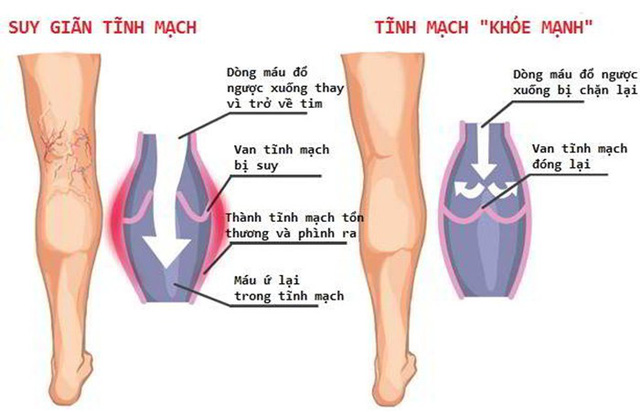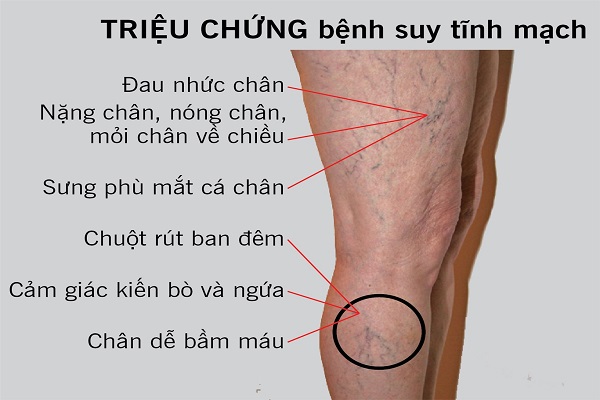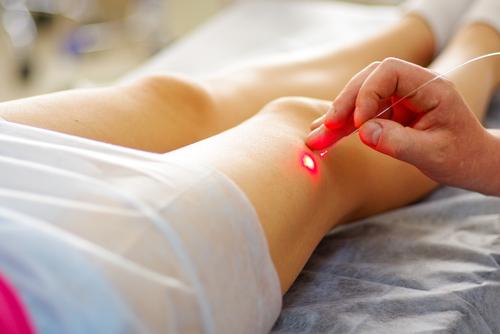What is varicose veins? There is no cure?
Varicose veins are a group of peripheral vascular diseases, often causing many inconveniences affecting the quality of life of patients.If not treated promptly, varicose veins can lead to dangerous complications, affecting the lives of patients.
content
- What is varicose veins?
- Causes of varicose veins
- Consequences of venous insufficiency
- Symptoms of varicose veins
- How to prevent and treat varicose veins?
What is varicose veins?
Varicose veins of thelegs (also called varicose veins of the lower limbs or varicose veins of the lower limbs) is a term used to refer to cases of venous blood not following the normal flow but reflux and stagnation in the outside. vi, changes in hemodynamics and deformation of the surrounding tissue organization, causing symptoms such as soreness, severe legs, leg edema, paresthesia paralysis, biting ants, cramps at night . veins can also lead to intractable complications such as eczema, long-term foot sores (especially in the elderly), bleeding, enlargement of superficial veins, superficial thrombophlebitis, and venous thrombosis. deep circuits .

Theoretically, varicose veins can occur in every vein in the body, however, in reality, most cases occur in the lower limbs.According to specialists, this happens because the long, complicated veins of the lower extremities and especially under the influence of gravity when the patient has to stand a lot.
Worldwide, varicose veins are a fairly common disease, more common in women than in men and the older it is, the more likely it is to develop it.People with a family history of someone who has the disease or who have to stand or sit for too long, sedentary also have a higher incidence than other people.
Causes of varicose veins

Currently, the pathogenesis of varicose veins has not been accurately determined.However, the medical community has determined that the cause of varicose veins is often related to functional damage to the unidirectional valves of the peripheral vein system.These valves are damaged due to:
- Genetic factors:According to statistics, up to 80% of patients with varicose veins have a parent once had the disease.
- Gender:The incidence of women is higher than in men due to the influence of female hormones, pregnancy and high-heeled hobby of many women.
- Occupation:Specific occupations that have to stand too long or sedentary such as teachers, salespeople, office workers, etc., the incidence rate is also higher.
- Body weight:The weight of the bodyhas a large impact that causes the blood to flow more toward the legs, causing peripheral stagnation.
- Birth control pills arealso a risk factor.
- Infectious diseases, tumors, postoperativecomplications of vascular occlusion, vasculitis and other procedures such as castings or prolonged immobilization in fractures . may also lead to varicose veins.
Consequences of venous insufficiency
Although varicose veins are not a life-threatening disease, they mainly cause discomfort, pain and loss of aesthetics and interfere with life, but if they are not treated for a long time, they will cause complications.Complications of the disease are often the formation of blood clots in the veins of the veins, which can cause local blood clots to block or travel through the bloodstream and cause another blockage, the most dangerous of which is Pulmonary embolism, can lead to respiratory failure and death.

Up to 77.6% of patients with varicose veins do not know they have the disease.In addition, many patients are also psychologically afraid to visit, not treated or treated incorrectly.This leads to very unpredictable consequences, possibly even leading to death.
There are three complications that people who suffer from varicose veins and varicose veins can experience if not treated properly are: Thrombosis (blood clot), hemorrhage (bleeding) and leg ulcers.
Enlarged veins, if not removed, present a risk of clotting, causing superficial thrombophlebitis.The blood clots formed in the lumen may peel off, followed by blood flowing back up into the lungs, clogging the lungs leading to death.The enlarged veins gradually will at one time burst when the injury or minor impact, causing bleeding, ecchymosis.Long-term metamorphosis of the skin on the lower leg will lead to eczema, hyperpigmentation and leg ulcers due to stagnation.
Symptoms of varicose veins
Varicose veins are a less dangerous disease if detected and treated promptly.Here are some manifestations of the disease that you should note to be able to detect the disease right from the onset.
Early stage

In the early stages of varicose veins, patients often experience symptoms such as:
- Unpleasant sensation in the calves, heavy legs, sometimes with a sense of heterosexual crawling, burning.
- Calf cramps usually occur at night.
- Swelling around the ankle, evident in the evening.
- Dilating capillaries and shallow veins in the legs.
- Frequent aches and pains in the legs.
- Symptoms increased in the evening, after standing for a long time and decreased after waking up, after resting, raising legs, applying ice .
Later stage
When the disease gets worse, venous thrombosis will form on the calf causing symptoms such as:
- Emerging veins that are visible to the naked eye, warm and rigid along the vein, are very painful and may be accompanied by skin redness, often called superficial venous thrombosis.Shallow venous thrombosis usually causes less life-threatening complications and consequences.
- Deep vein thrombosis:Hot feet, redness, aches and pains, itching, possible bleeding, secondary infection.Deep vein thrombosis can be life-threatening because the thrombus may peel and travel to the lungs, causing pulmonary embolism.
- Dermatitis foot:Skin edema, thickening, can peel skin, watery and change color
- Foot ulcers:Very painful ulcers appear. Initially, the ulcer becomes shallow and deeper and wider, easily causing bacterial superinfection.
How to prevent and treat varicose veins?
How difficult it is to treat varicose veins is a question of many people who discover the symptoms of the disease.Currently, to treat this pathology, there are a number of commonly used remedies: Medical treatment, lint, surgery and laser.
Internally medical treatment

Common medical treatments that are commonly used aremedical socks, painkillers, anti-inflammatory drugs, and lifestyle changes.
- Medical stockings:Has the effect of squeezing the muscles, creating a large pressure on the bottom and helping the venous valves to close, thus helping blood flow to the heart more easily.This device helps to slow the progression of the disease, prevent relapse and support surgical treatments.
- Medication:Analgesics, anti-inflammatory, analgesic, sustained vascular stability, blood clots . are often prescribed by doctors for mild and moderate cases.
- Change of living habits:According to the doctors, varicose veins are social pathologies, much related to diet and work.Therefore, when sick, we should change our living habits: Limit long standing, long sitting, heavy porters, regular physical exercise and sports.In particular, swimming is a suitable sport to treat this pathology.
Prick fibrous
A solution is injected into the patient's vein causing an inflammatory reaction in combination with compressing the vein, preventing blood from entering the vein.As a result, the vein becomes fibrous and no longer works.
Surgery
Surgery is often used for superficial damage to the veins, the dilated vein is removed through small incisions.The surgery usually takes about 5 - 10 minutes.After surgery, the patient will be put on a bandage and remain motionless in bed for about three days.
Laser

Intravascular laser resection of a varicose vein is a way of using heat from the laser fiber to ignite the varicose vein, causing it to be destroyed.This treatment will be performed throughout the entire length of the varicose veins.Treatment time of laser method usually lasts about 30-40 minutes.
In addition, if there have been superinfection and ulceration in the foot, in addition to the above methods, it is necessary to combine treatment, care at the ulcer and use antibiotics to combat superinfection, deeper ulcers.
It can be seen that varicose veins are a common disease and if detected, treated early, it is usually not dangerous to the lives of patients.Therefore, each of us must always consciously take care of our health, eat, drink and rest scientifically and healthily to avoid suffering from the same conditions, affecting the quality of life of ourselves. Dear.The information we provide hopes has helped readers to be somewhat aware of this problem.I wish you always happy health and good study.
You should read it
- 16 great benefits from lemon you may not know yet
- 15 miraculous uses of lemon you may not know
- Why are human veins green while blood is red?
- New technology: Use low-frequency ultrasound to break blood clots deep in the leg veins
- How to Replace an RV Waste Valve Handle
- Valve does not block the use of AI, but will reject games that use AI that violate copyright
- Nvidia shakes hands with Valve to bring the DLSS experience to Linux
- Valve set a record with 7 million Steam users at the same time
May be interested
- Medicinal dishes to help cure bedwetting
 if children with bedwetting are thin, pale, and afraid of cold, they should eat warm foods to help cure bedwetting
if children with bedwetting are thin, pale, and afraid of cold, they should eat warm foods to help cure bedwetting - What is allergic rhinitis? There is no cure?
 allergic rhinitis is a disease we often hear about, but not everyone has an accurate understanding of it.
allergic rhinitis is a disease we often hear about, but not everyone has an accurate understanding of it. - Can you cure your laptop yourself?
 your daily work always needs a laptop, but suddenly it collapses 'dead' for many different reasons. how to deal with these situations?
your daily work always needs a laptop, but suddenly it collapses 'dead' for many different reasons. how to deal with these situations? - 1 minute rule to cure lazy, what do you think?
 this japanese principle called kaizen works to help you overcome yourself to defeat laziness.
this japanese principle called kaizen works to help you overcome yourself to defeat laziness. - 12 ways to treat headaches immediately without using drugs
 there is no need to use western medicine, but it is still effective in treating headaches if these measures are applied.
there is no need to use western medicine, but it is still effective in treating headaches if these measures are applied. - Nvidia urged millions of PC gamers to lend their computers to scientists to study the cure for COVID-19
 in the context of covid-19 spreading rapidly across the globe, you can partially support the research process of the cure if you own a high-configuration pc
in the context of covid-19 spreading rapidly across the globe, you can partially support the research process of the cure if you own a high-configuration pc - Australia: A professor claims to have discovered the 'cured' drug Covid-19
 a team of australian researchers say they have found a cure for covid-19, and hope to launch a nationwide clinical trial as soon as this march. professor david paterson, director of the center for clinical trials at the university of queensland, revealed:
a team of australian researchers say they have found a cure for covid-19, and hope to launch a nationwide clinical trial as soon as this march. professor david paterson, director of the center for clinical trials at the university of queensland, revealed: - Causes, ways to prevent and cure tinnitus when flying
 many people often suffer from tinnitus, earache when the aircraft takes off or lands. this phenomenon can affect hearing within a week after the flight ends. you can completely remedy this situation by chewing gum or simply yawning ...
many people often suffer from tinnitus, earache when the aircraft takes off or lands. this phenomenon can affect hearing within a week after the flight ends. you can completely remedy this situation by chewing gum or simply yawning ... - The magic thing will happen if you massage this point on the forehead
 we have a habit of having a headache when rubbing both sides of the temple or neck to relieve pain. however, there is still an equally simple way that not everyone knows. it is the massage and pressing on the acupoint just above the point of delivery of two eyebrows.
we have a habit of having a headache when rubbing both sides of the temple or neck to relieve pain. however, there is still an equally simple way that not everyone knows. it is the massage and pressing on the acupoint just above the point of delivery of two eyebrows. - How to Cure Vampirism in Skyrim
 you can get vampirism in skyrim by fighting vampires or siding with the volkihar clan in the dawnguard expansion. the vampiric trait increases your magic and resistance stats, but at the same time reduces your abilities during the day and increases your damage when exposed to fire. there are many ways to cure this disease before complete transformation, such as taking special medicine or praying at the shrine. to undo it after officially becoming a vampire, you need to do the 'rising at dawn' quest requested by falion in morthal.
you can get vampirism in skyrim by fighting vampires or siding with the volkihar clan in the dawnguard expansion. the vampiric trait increases your magic and resistance stats, but at the same time reduces your abilities during the day and increases your damage when exposed to fire. there are many ways to cure this disease before complete transformation, such as taking special medicine or praying at the shrine. to undo it after officially becoming a vampire, you need to do the 'rising at dawn' quest requested by falion in morthal.










 Top 5 heart rate monitors and SpO2 good finger grip, cheap
Top 5 heart rate monitors and SpO2 good finger grip, cheap Found the bird preserved naturally in the permafrost, 46,000 years intact
Found the bird preserved naturally in the permafrost, 46,000 years intact Close-up shot of 'killer' of pistol shrimp, speed 97km / h
Close-up shot of 'killer' of pistol shrimp, speed 97km / h Detecting the second Moon of the Earth, the diameter is only about 3.5m
Detecting the second Moon of the Earth, the diameter is only about 3.5m Scientists generate electricity from the air by nanowires generated from bacteria
Scientists generate electricity from the air by nanowires generated from bacteria Why do ants often move in a row?
Why do ants often move in a row?